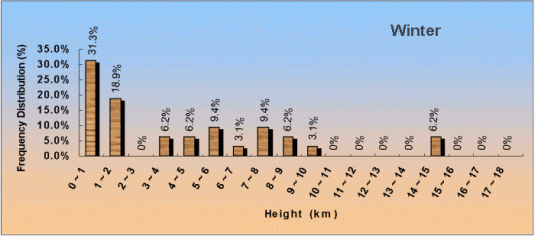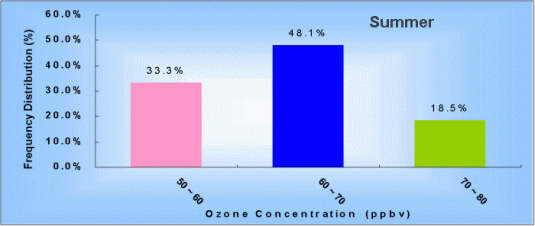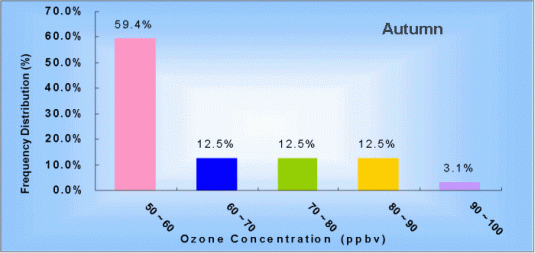Ozone
OZONE PROFILES OVER HONG KONG
INTRODUCTION
Although some 90% of atmospheric ozone reside in the stratosphere and only 10% in the troposphere, tropospheric ozone is nevertheless important in its own right. This is because apart from being a pollutant at the surface, tropospheric ozone
i). acts as a greenhouse gas and influences the radiative forcing of the climate system
ii). serves indirectly as a 'detergent' and removes gases such as carbon monoxide and methane (Mohnen, 1995).
To understand the characteristics of vertical ozone distribution over Hong Kong and to provide the international community with data from this part of the world, such information being scarce and are needed for better understanding of the ozone layer and its changes (World Meteorological Organization, 1996), the Hong Kong Observatory began operating balloon-borne ozone sondes in December 1993 (Shun and Leung, 1993).
To-date, over 170 vertical soundings have been successfully made, some in collaboration with the Hong Kong Polytechnic University. Honouring its commitment as a World Meteorological Organization Global Atmospheric Watch (GAW) station the Hong Kong Observatory has deposited its ozone profile data with the World Ozone Data Centre in Toronto for access by the international community.
Ozone profiles often show a laminated structure with layers of maxima and minima. Newell et al. (1996, 1997) have analyzed the statistics of tropospheric layers of ozone and other trace gases observed by aircraft over the western North Pacific.
In this page, statistics on the ozone maxima nearest the ground observed by ozone sondes over Hong Kong are furnished.
| STATISTICS | |
 |
|
|
The laminated structure of vertical ozone profiles is demonstrated in the sample profile shown in the panel on the left. The first of a series of maxima, about 70 ppbv in concentration, occurs at about 0.5 km above ground. This maxima is in the boundary layer which extends to about 2 km as marked by the first inversion on the temperature ascent. The second maxima is found at about 4 km. It is broader, and its concentration higher (about 100 ppbv). It is also the largest of the tropospheric maxima in the profile. The ozone profile also shows a broad minima in the upper troposphere between about 13 and 15 km. These altitudes, just below the tropopause, should usually be ozone rich because of its proximity to the stratosphere. Newell (1997) has suggested that minima such as this is due to the air having first been cleansed by mixing with clean marine air and then lifted to the upper troposphere by deep convection. | |
 | |
| On an annual basis, just under 80% of the troposphere ozone maxima appear in the lower troposphere, below about 6 km. About 18% occur in the mid-troposphere between about 6 and 12 km. Just over 2% are found in the upper troposphere where the effect of ozone on climate change is the most important.
| |
 | |
| In spring, the maxima occurs predominantly at the 3-4 km altitude, above the boundary layer. Back trajectory analysis suggests that these maxima result from biomass burning over continental Southeast Asia which takes place mainly in spring (Yeung et al., 1996; Liu et al., 1999).
| |
 | |
| Possibly due to the stronger convection, summer finds the ozone maxima occurring higher up, at about 4-7 km.
| |
 | |
| In autumn the maxima are located most frequently between 1-3 km. These near surface maxima probably have their origins in local pollution.
| |
 | |
| Winter again sees the maxima occurring most often in the boundary layer. The variation with season demonstrates the influence of meteorology on where in the troposphere the maxima would occur.
| |
 | |
| In terms of the concentration, the majority of the ozone maxima has a concentration that is in the 50 to 60 ppbv range, but concentrations as high as 130-140 ppbv are also found. The frequency of occurrence decreases monotonically with concentration.
| |
 | |
| Spring in Hong Kong is the season in which the largest concentration, 130-140 ppbv, is found.
| |
 | |
| Summer, on the other hand, finds no maxima above 70-80 ppbv. Maxima with concentrations less than 70 ppbv pre-dominate.
| |
 | |
| In autumn, maxima with concentrations in the range 50-60 ppbv pre-dominate. Occurrences of maxima with concentration in the 60-70 ppbv, 70-80 ppbv and 80-90 ppbv seem to be quite evenly distributed. Compared with summer, there is a shift towards higher concentrations.
| |
 | |
| Concentrations in the range 50-60 ppbv is also the most abundant in winter. Maxima with concentrations in the 100-110 ppbv range begin to appear.
| |
| References
Liu, Hong Yu et al., 1999: On springtime high ozone events in the lower troposphere from Southeast Asian biomass burning. Atmospheric Environment, 33, 2403-2410. Mohnen, Volker A., Walter Goldstein and Wei-Chyung Wang, 1995: The potential role of tropospheric ozone as a climate gas. World Meteorological Organization Bulletin, 44, 38-42. Newell, R. E. et al., 1996: Vertical fine-scale atmospheric structure measured from NASA DC-8 during PEM-West A. J. Geophys. Res., 101, 1943-1960. Newell, et al., 1997: Western Pacific tropospheric ozone and potential vorticity: implications for Asian pollution. Geophys. Res. Lttrs., 24, 2733-2736. Shun, C. M., and K. S. Leung, 1993: The first radioactivity and ozone soundings in Hong Kong. HKMetS Bulletin, 3, 21-27. World Meteorological Organization, 1996: Report of the International Workshops on Ozone Observations in Asia and the Pacific Region. WMO TD No. 827. Wu, Zhongxiang et al., 1997: Atmospheric layers measured from the NASA DC-8 during PEM-West B and comparison with PEM-West A. J. Geophys. Res., 102, 28,353-28365. Yeung, K. K. et al., 1996: Tropospheric ozone profiles over Hong Kong. HKMetS Bulletin, 6, 3-12. |
| GLOSSARY |
| Biomass : The dry weight of all living matter. |
| Boundary layer : The layer of the atmosphere lying immediately adjacent to the earth's surface. It is the layer most influenced by heat and momentum exchange with the earth's surface. |
| Maxima : Ozone concentration reaching a peak value. |
| Minima : Ozone concentration reaching a smallest value. |
| ppbv : Part per billion per volume, a concentration unit for gases. |
| Stratosphere : The layer of the atmosphere extending from the tropopause to about 50 km above ground. |
| Trajectory : The path of a travelling particle in the atmosphere. |
| Troposphere : The layer of extending from ground to the tropopause. |
| Tropopause : The boundary between the troposphere and the stratosphere. The tropopause is found at about 15 km above the earth's surface in the tropics and 20 km in the high latitudes. |